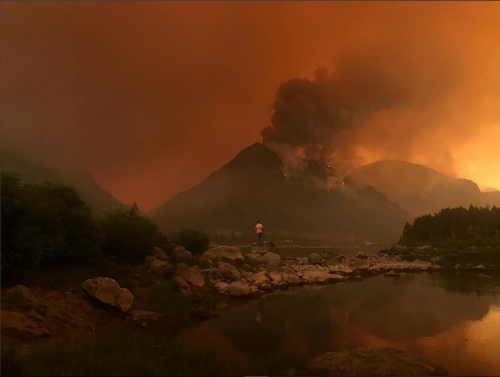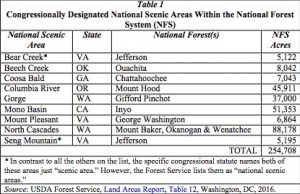The Columbia River Gorge is Dead;
11th of Oct 2017

Long Live the Columbia River Gorge – Unless Greg Walden Has His Way
By Andy Kerr – Originally published on his Public Lands Blog
Part 1: It’s a Beautiful, Natural, and Necessary Thing That Nature Changes
September 29, 2017
Everyone—including many a card-carrying conservationist—just needs to take a deep breath. Yes, there was a relatively large forest fire mostly on the Oregon side of the Columbia River Gorge. However, the clearing of the smoke gave proof through the day that our gorge was still there. The Columbia River Gorge was not “destroyed,” “lost,” “gone up in smoke,” “consumed,” or “dead,” as suggested by generally hyperbolic media reports by generally hysterical reporters, often quoting generally hysterical gorge lovers.
Yes, the fire covered a lot of acres and some of those acres burned hot (and that’s ecologically okay), with most, if not all, large trees being burned. (Not all charred trees will die, unless Representative Walden has his way; see Part 2.) The fire, like all forest fires, burned in a mosaic pattern and left some patches unburned and lightly burned. However, unburned or lightly burning or burned forest makes for poor video for the 24-hour news cycle.

A black-backed woodpecker chowing down. Though the convention is not universally followed, a blue paint mark usually means the tree is marked to be cut down. Source: Rob Routledge, Sault College, Bugwood.org.
This 2017 Columbia River Gorge fire changed the gorge, just as did the 1902 fire (covering 170,000 acres in Oregon and 604,000 acres total). Both were driven by high winds and low humidity. Both were human caused but could just as easily have been caused by lightning. Forest fires happen and are generally a good thing if one is willing to consider perspectives other and longer than one’s self-centered my-view-changed-and-I’m-unhappy-about-it perspective. The forests of the Columbia River Gorge so beloved before this most recent fire were sculpted by fire. (Some of the forest that is privately owned—located mostly on the Washington side—was also sculpted by clear-cuts and is nowhere near as scenic today.)
If your appreciation of the landscape and the vegetative beauty of the Columbia River Gorge is purely aesthetic, rooted in the present human moment and centered on the present human self, you are inconsolable and no one can help you. But you can help yourself rise above your momentary grief by realizing and appreciating that scenic beauty is more properly underpinned by both form and function. For forests to function, their form must occasionally change. The old-growth forests of today weren’t always that way but were born of major disturbance—whether fire, windstorm, insects, disease, or volcano. The “classic” (pronounced “before the latest burn”) beauty of the forests of the Columbia River Gorge is at this very moment being replaced by a new beauty.
Perhaps you’ll find solace listening to the renowned forest ecologist Jerry Franklin in the episode entitled “The Ecosystem of Forests and Fires” on Oregon Public Broadcasting’s Think Out Loud, where he puts the recent fire in the gorge into a long-term ecological perspective.
The charred or singed forests will be quite a beautiful sight for the descent of woodpeckers (the collective noun for a grouping) that will descend upon the area for a feast—in this case black-backed woodpeckers. Their black backs are an evolutionary adaptation for camouflage as they work over the scorched tree trunks. Black-backed woodpeckers are being considered for Endangered Species Act protection because of the generally routine practice of salvage logging after a fire. (See the August 2017 New York Times article entitled “Let Forest Fires Burn? What the Black-Backed Woodpecker Knows.”) When spring comes, so will wildflowers in profusions not known in closed-canopy forests. Among the wildflowers will sprout grasses and shrubs that support particular kinds of wildlife.
Consider these two examples recent enough for many of us to remember:
• Until Sunday, May 17, 1980, north of the Columbia River Gorge stood the post-card gorgeous, classically Fuji-shaped snow-capped peak with old-growth forests on its slopes (and also some industrial clear-cuts, by the way) Mount Saint Helens. Then it blew up and away in a rather large—at least compared to what we’ve witnessed in recent times—volcanic eruption. Spirit Lake as we knew it is gone, but Spirit Lake is still there, albeit in a starkly different form. Mount Saint Helens is still there, albeit a few cubic miles smaller. The forests not covered by lava flows are coming back and—if not covered in another volcanic eruption—will likely become old-growth forest again. Of course, we’ll all be long dead.
• Though the media proclaimed the destruction of Yellowstone National Park due to the fires of the summer of 1988, Yellowstone National Park is still there—still beautiful and even more functional. Wolves, bison, elk, eagles, fumaroles, geysers, and all that stuff are still there.
I could go on and on, but I won’t. Neither volcanic eruptions nor forest fires can be prevented—and that’s a beautiful thing.
Part 2: Simply an Excuse and a Mandate to Clear-Cut
October 6, 2017
In 1986, Congress enacted the Columbia River Gorge National Scenic Area Act to, among other things, “establish a national scenic area to protect and provide for the enhancement of the scenic, cultural, recreational, and natural resources of the Columbia River Gorge.” In 2017, Representative Greg Walden (R-2nd-OR) proposes to throw it out the window.

Rep. Greg Walden (right) represents Oregon’ 2nd congressional district that includes a portion of the Columbia River Gorge National Scenic Area.. Source: Chip Somodevilla, Getty Images
Even before the Columbia River Gorge fire was doused by autumn rains, Walden had introduced his Scenic Columbia Gorge Restoration Act of 2017 (H.R.3715, 115th Congress; pronounced “Columbia Gorge Clear-Cut Act of 2017”). The Walden bill is a truly depraved, cynical and opportunistic legislative response. Had Walden been in Congress in 1902 and had his bill been enacted into law, all of the Columbia River Gorge would have been promptly clear-cut and replaced with a monoculture plantation of industrialized Douglas-fir. Even if those plantations lasted 115 years (they would likely be clear-cut at least twice in that period of time), they wouldn’t contribute to the scenic grandeur of the Columbia River Gorge. Aesthetically, it might look like the gorge was carpeted in AstroTurf®. Walden doesn’t seem to appreciate the ecological importance of complex early seral forest, the stage of forest development after the disturbance of a late successional forest, more commonly known as a mature and/or old-growth forest.
Walden’s bill includes not only the Columbia River Gorge National Scenic Area but every other national scenic area within the National Forest System (Table 1).

Walden’s bill would authorize and direct the Forest Service to promptly clear-cut and plant conifers in any national scenic area affected by a “catastrophic event,” which his bill defines as
. . . any natural disaster (such as hurricane, tornado, windstorm, snow or ice storm, rain storm, high water, wind-driven water, tidal wave, earthquake, volcanic eruption, landslide, mudslide, drought, or insect or disease outbreak) or any fire, flood, or explosion, regardless of cause.
In other words, nature happening is a catastrophic event. The “such as” wording leaves open the possibility that too many red tree vole (an imperiled denizen of older forests) sneezes—either concurrent and/or consecutive—could be interpreted by the Forest Service as a “catastrophic event.”
In response to each “catastrophic event,” the Walden bill requires the Forest Service to do “response activities,” meaning
. . . any salvage operation or reforestation activity proposed to be conducted within a National Scenic Area adversely impacted by a catastrophic event to address conditions caused or exacerbated by the catastrophic event.
“Salvage operation” is legislative code language for logging all the big trees and selling them. The bill then sets a “reforestation objective” for the “response activity”:
In the case of response activities conducted on National Scenic Area lands adversely impacted by a catastrophic event, the Secretary shall achieve reforestation of at least 75 percent of the impacted lands before the end of the two-year period following the conclusion of the catastrophic event.
“Reforestation” is legislative code language for artificial planting, which necessitates clear-cutting the area beforehand. Such “response activities” must begin within thirty days of “conclusion” of the catastrophic event, which
includes containment of the catastrophic event if occurring before the actual end of the catastrophic event.
Save perhaps for a mudslide or a landslide, the only kind of “catastrophic event” the Forest Service even tries to “contain” is a fire. Earthquakes, tidal waves, volcanic eruptions, hurricanes, tornados, and all other kinds of storms are not conducive to “containment.” (Neither are fires, but the Forest Service pretends they are so as to keep the money flowing.) It’s all about clearcutting.
If the “response activity” does not exceed 10,000 acres and is visible from viewing areas (including the Washington side of the Columbia Gorge National Scenic Area, so effectively anywhere), there would be a “categorical exclusion” from any public input or planning and evaluation required by the National Environmental Policy Act (NEPA), and thus no judicial review. The Forest Service could simply create a few distinct 10,000-acre “response activities” and clear-cut the Gorge with impunity.
The Forest Service would also get to decide for itself if its actions might adversely affect an Endangered Species Act (ESA) listed species or its critical habitat. The standard ESA practice is that the fox doesn’t get to determine if henhouse management is good for the hens. If the Forest Service did deign to consult with the Fish and Wildlife Service and/or the National Marine Fisheries Service, it could ignore any findings by the fish and wildlife agencies that imperiled species are being harmed because there would be no judicial review of any “response activity.”
The boundary of the Columbia River Gorge National Scenic Area abuts the original 39,000-acre Mark O. Hatfield Wilderness (originally named the Columbia Wilderness when established in 1984). In 2009, Congress expanded the Hatfield Wilderness by 25,946 acres, all in the Columbia River Gorge National Scenic Area. Walden voted in favor of that expansion that put 56 percent of the Forest Service land on the Oregon side of the Columbia River Gorge National Scenic Area into the National Wilderness Preservation System. Walden’s 2017 bill would require salvage logging in designated wilderness if it is within a national scenic area. (Another 8,344 acres of qualifying roadless lands, mostly in the Columbia River Gorge National Scenic Area, could and should be added to the Hatfield Wilderness, but I digress.)
Though I dispute and lament the Chicago Tribune headline “Fire Devastates Oregon’s Columbia Gorge—And Nature Lovers,” I nonetheless am glad this was the last words in the story:
Lt. Damon Simmons, a spokesman with the Oregon Fire Marshal, on Wednesday drove the historic Columbia River Highway, a winding, two-lane road that parallels the river on the Oregon side and offers majestic viewpoints from the gorge’s steep cliffs. He came back with a hopeful message.
“The gorge still looks like the gorge,” he said. “It’s not a wasteland. It’s not a blackened, destroyed no man’s land.”
In the name of keeping the Columbia River Gorge scenic, natural, wild and wonderful for this and future generations, Representative Walden should stand down.
Andy Kerr is the Czar of The Larch Company and consults on environmental and conservation issues. The Larch Company is a for-profit non-membership conservation organization that represents the interests of humans yet born and species that cannot talk. He is best known for his two decades with the Oregon Wild (then Oregon Natural Resources Council), the organization best known for having brought you the northern spotted owl. Kerr began his conservation career during the Ford Administration.

